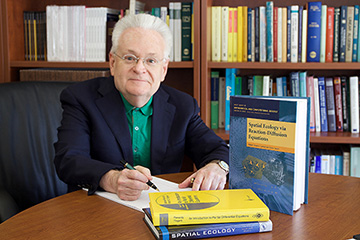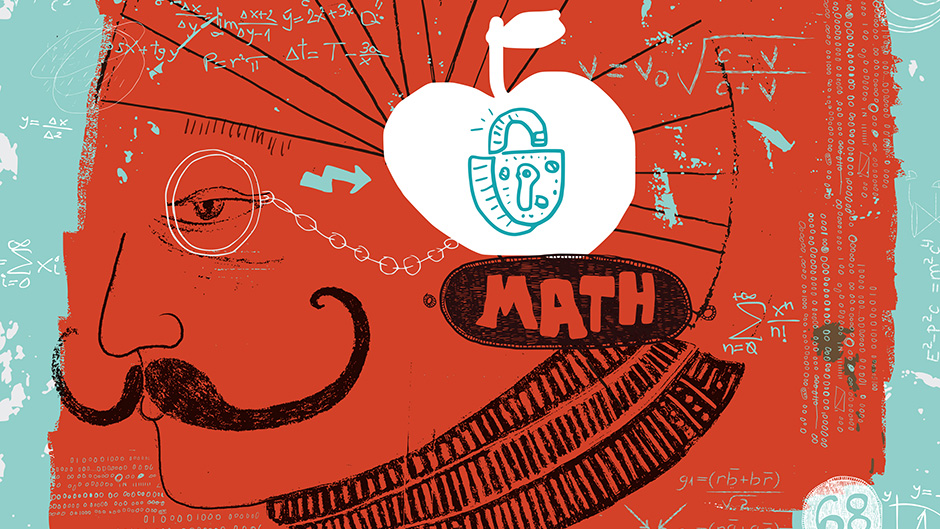In some ways, the University of Miami’s Mathematics Department is a time machine, building on the formal principles of the past to reach beyond the known into a theoretical future. It’s also a bridge, linking students and faculty across disciplines and across continents.
Ludmil Katzarkov, whose research interests involve algebraic geometry, symplectic geometry, and string theory, is in the vanguard of both.
His participation in the Simons Collaboration on Homological Mirror Symmetry, launched in late 2015, involves a field of mathematics inspired by theoretical physics. He and a post-doctoral research assistant professor, Andrew Harder, are representing the University of Miami in a multi-institutional project involving the University of Pennsylvania, Harvard, Berkeley, and Brandeis, among others. Funding comes from a Simons Foundation grant, which, as its website says, aims to “stimulate progress on fundamental scientific questions of major importance in mathematics.”
In this case, the goal is to prove mirror symmetry, a conjecture formulated by University of Miami Distinguished Professor Maxim Kontsevich, which springs from the world of theoretical physics.
As Katzarkov put it: “Mathematics could be forgiven for thinking itself a fairy godmother to the other sciences, sprinkling useful theories and theorems into biology, chemistry and physics, enabling them to reach new heights. Sometimes, however, it goes the other way.”
Other grants, including several from the National Science Foundation, fuel cutting-edge research in a variety of areas that extend into other disciplines and real-world issues.
 |
| Stephen Cantrell, chair of the Mathematics Department in the College of Arts and Sciences. |
Among them, Department Chair Stephen Cantrell and Professor Chris Cosner are working with NSF funded postdoctoral fellow Xiao Yu on a project at the intersection of the mathematical and biological sciences, examining evolution and ecological effects of dispersal in ecological communities. Assistant Professor Bruno Benedetti, now in his second year with the University, earned an NSF grant this summer to explore geometric combinatorics and discrete Morse theory.
And Shigui Ruan is the recipient of a continuing NSF grant for his research providing mathematical models for preventing and controlling vector borne disease such as the mosquito-borne and sexual transmissable Zika virus. His research also has made him something of a media celebrity, with reports on NPR, Canada’s CTV television network, and other outlets around the world.
Grants play an important part in furthering the department’s work. So do gifts from generous alumni. This year, the Mathematics Department welcomes its first named post-doctoral research assistant professor, funded through a $250,000 gift from alumnus Jeffry B. Fuqua. This year’s Fuqua Research Assistant Professor is José Samper, who will be working in combinatorics with Michelle Wachs Galloway, herself a recipient of the inaugural Provost’s Funding Award in recognition of her continuous NSF funding dating to the early 1980’s.
Departmental faculty members have been the recipients of various distinguished prizes and recognitions. Professors Wachs Galloway, Greg Galloway, and Katzarkov have all been Simons Foundation Fellows. Those three, along with Professor Cosner, also have been Cooper Fellows, the College of Arts and Sciences highest award. And Professor Ruan was named as a Thompson Reuters Highly Cited Researcher for both 2014 and 2015.
Also, this year, the department is extending its reach across borders with a pioneering co-mentoring collaboration. In addition to his mirror symmetry project, Katzarkov will be working with two research assistant professors forging a link between the University of Miami and Mexico’s CINVESTAV, that country’s renowned Center for Research and Advanced Studies of the National Polytechnic Institute known by the acronym for its name in Spanish, Centro de Investigacion y de Estudios Avanzados del Instituto Politecnico Nacional.
The two post-doctoral students will spend alternating semesters at each of the two institutions.
“We have exchanged people for short visits but now we are going to the next level and exchanging postdocs,” Katzarkov said. “We hope eventually that it amounts basically to a joint institute here in Miami.” In the process, it offers a unique component in UM President Julio Frenk’s vision of the university’s mission.
“It's very much in tune with making this a hemispheric university,” Cantrell said. “I think it's a very novel thing. It requires a special kind of person that's prepared to live half a year one place and then half a year in another place for a couple of years back and forth.”
Eventually, Cantrell said, the hope is that the program will expand to include more students, in more mathematical fields. It also could expand to include more institutions.
The department is innovating in other areas, as well. It began offering a new Master of Science in Mathematical Finance this fall, “geared toward people in the financial industry that need advanced math abilities and their work,” Cantrell said.
The department is working with an external advisory committee of financial professionals, and plans to open a Trading Lab for this coming spring where students will have access to actual real data. It also expects to host a University-wide event with the Treasury Department’s Acting Assistant Secretary for Financial Markets, Daleep Singh.
“What we are hoping to accomplish is to give yet another application of mathematical sciences. These days finance in general is getting to be more and more of a data science field, more and more of a mathematical field,” said Associate Professor and Associate Chair Alexander Dvorsky, who heads the new master’s program. The master’s program “aims to take people who have some strong undergraduate technical training and give them some training on how to use those tools in finance.”

